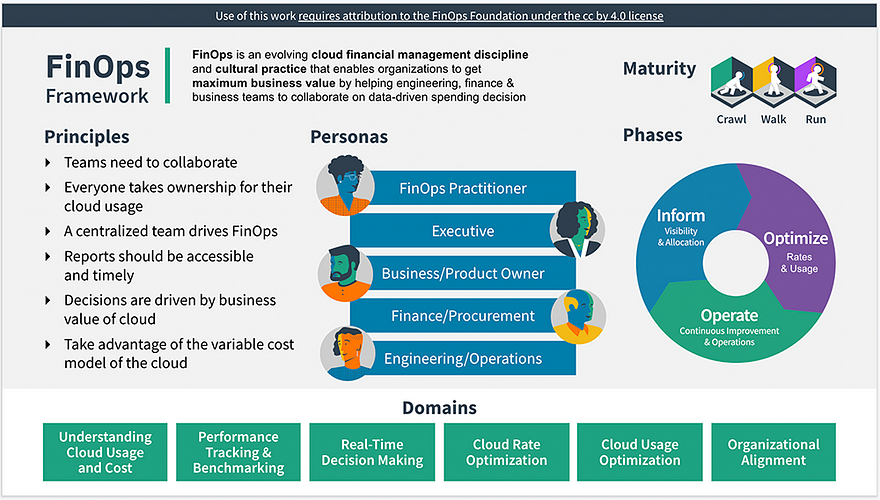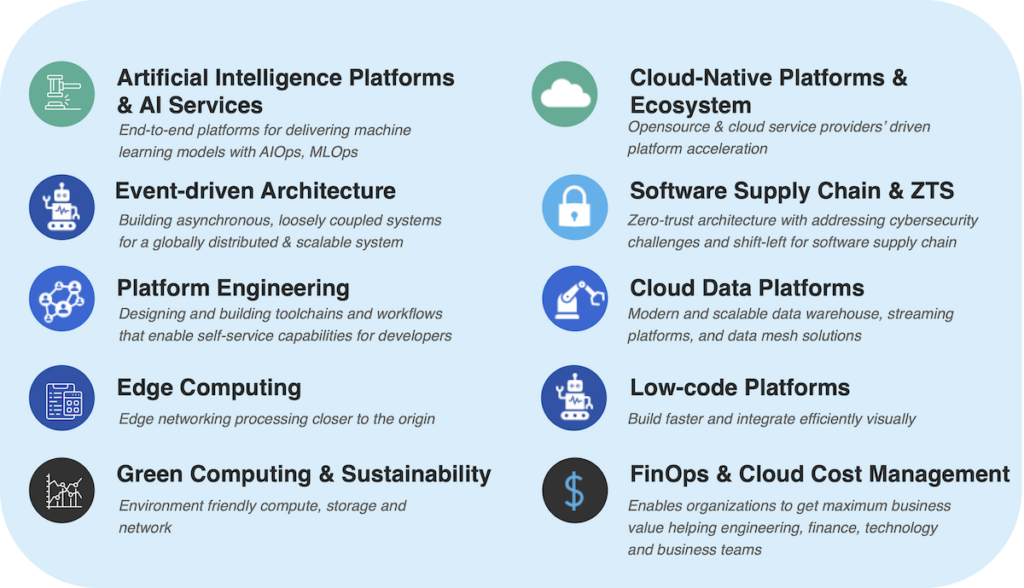Observing technology trends by analysts, research companies, and thought leaders provides a broader perspective. It not only helps software architects to understand the impact of technologies being adopted but also helps them build the right skill set for themselves or their team. This article synthesizes the top ten technology trends for 2023 and beyond based on broader research.
This article is in continuation to our previous article for 2022 — click here to read more.
#1 — Artificial Intelligence Platforms & AI Services
- The rise of OpenAI’s ChatGPT with a 100M+ user base has set the trend to leverage AI Services to create innovative solutions across different industries. Microsoft has announced an investment of $10B in OpenAI to continue its investment toward a competitive edge using AI.
- AI Platforms such as Dataiku, Amazon Sagemaker, Azure AI, Google Vertex AI, DataRobot, IBM Watson, and H2O.ai continued to trend to enable enterprise organizations to build AI & ML capabilities.
- Generative AI capabilities help to create engaging non-fiction text, digital images, and video and audio content. Click here to read more about Generative AI.
- Causal AI will emerge as a new approach to generate insights from data. Click here to read Gartner’s view on using Casual AI for co-relation-based prediction.
- AI Everywhere — No-code AI, Contactless autonomous shopping, and autonomous delivery will continue to trend. Robots will not only perform mundane human-like activities such as greeters, bartenders, receptionists, etc. but also perform complex tasks in warehouses and factories.
We predict that in 2023, AI adoption within enterprises will continue to expand and be more creative, trustworthy, and optimized.
#2 — Cloud-Native Platforms & Ecosystem
- While specific industries and enterprises are ahead in the adoption of the Cloud, there are technology laggards — 2023 will continue to see the acceleration with the help of Cloud-native platforms.
- Gartner predicts adoption of industry cloud will rise, which is a major shift to build cloud platforms for a specific user’s industry (from generalization to specialization).
- Serverless as a platform is a key enabler to reap the benefits of Cloud-native with minimal operational overhead and will continue to be the preferred approach based on the enterprise’s maturity.
- Opensource cloud-native technologies will continue to support the innovation ecosystem with communities as CNCF fosters vendor-neutral technologies.
The cloud-native landscape has consolidated 1000+ technologies with an overall market cap of $21.1T and funding of $66.7B.
(Source: The CNCF Landscape)
#3 — Event-driven Architecture
- While Event-driven Architecture (EDA) has been around for more than a decade, it has reached mainstream adoption to build modern applications. Cloud-managed services have addressed the infrastructural challenges and enhanced observability capabilities have addressed troubleshooting, tracing, and monitoring challenges.
- The key theme of Werner Vogels’ keynote highlights the benefits of building asynchronous, loosely coupled systems, and how event-driven architecture is the need of the hour to build globally scalable systems. Click here to read more about key takeaways from AWS re: Invent 2022.
- Practitioners of technologies such as Kafka, NATS, Solace, AWS Eventbride, Google Cloud Eventarc, Azure Event Grid, AxonIQ, Lightbend Akka, and many more have shared best practices and Serverless offerings to make the implementation of EDA applications easier.
Event-driven architectures are the ones that you should use to build applications that need to work at a global scale.
#4 — Software Supply Chain & Zero Trust Security
- Shift-level to uncover security vulnerabilities early in the software supply chain will continue to be on priority this year. DevSecOps implementation will get accelerated in 2023 and will continue to be in mainstream adoption.
- Gartner recommends creating a Digital Immune System to mitigate security risks elevating user experience. Software Supply Chain Security is one of the pillars of creating the digital immune system.
- Zero Trust Adoption, Secure Access Service Edge (SASE), Rise of Ransomware, Security Hacks & Threats, and Big Breaches are some of the Cybersecurity predictions by Forrester. Click here to read more.
- While there are traditional communities such as NIST, Open source communities — OpenSSF — will continue to emerge for open-source security initiatives. Click here to read about the consolidated knowledge on Security.
Worldwide Spending on Security & Risk Management Forecast to Grow 11.3% in 2023. Three factors influencing growth in security spending are the increase in remote and hybrid work, the transition from virtual private networks (VPNs) to zero trust network access (ZTNA) and the shift to cloud-based delivery models.
(Source: Gartner Report)
#5 — Platform Engineering
Platform engineering is the discipline of designing and building toolchains and workflows that enable self-service capabilities for software engineering organizations in the cloud-native era.
(Source: Platform Engineering Community)
- Platform Engineering has emerged as a major technology trend as it not only helps to increase the productivity of the developers but also helps to provide consistency in enterprises.
- Interestingly, with the increasing complexity of Cloud-based architecture, a plethora of technologies are available supporting cloud-native ecosystems (CNCF landscape with 1000+ technologies), and multi/hybrid cloud solutions. This has increased cognitive overload for developers and needs simplification (the whole purpose of platform engineering is to simplify developers’ experience). Be aware of the cognitive load and use platform engineering judiciously (it is not just a means to add more tools).
- Team Topologies (a book by Matthew Skelton and Manuel Pais) has emerged as a great reference for building an effective platform team.
#6 — Cloud Data Platforms
- While Snowflake continued its tremendous growth journey in 2022, this year will be the expansion of the ecosystem for Snowflake like Cloud Data Platform. Snowflake has already launched Unistore to provide a unified platform for both transactional and analytics data.
- Other players gaining momentum to build an enterprise data platform are: Databricks, AWS Redshift, Cloudera, Google Cloud BigQuery, and the list goes on.
- Data Mesh is emerging as a key trend as part of building enterprise data platforms changing the whole dynamics of ownership of data with Data-as-a-Product.
- Artificial Intelligence Services + Multi-Cloud Data Platform + Data Mesh + Mobile or Web Apps Edge Processing = Success Mantra — This will continue to be the trend in 2023 and beyond.
Customer Data Platform Market Rising at a CAGR of 24.5% to Reach USD 4,364.7 Million by 2027.
(Source: Fortune Business Insights)
#7- Edge Computing & IoT
- With new or upcoming ultra-fast networks like 5G and Wi-Fi 6E, edge computing will continue to rise further in 2023.
- Smart devices are predicted to be quadrupled by 2025 providing impetus to focus on edge computing for the Internet of Things (IoT).
- Primary cloud vendors (AWS, Azure, Google Cloud) will continue to enhance capabilities for Edge Cloud — AWS for the Edge, Google Distributed Cloud for Edge, and Azure private edge computing.
The total edge computing addressable market will grow to US$543 billion in 2030 at a CAGR of 49% over the 10-year period.
(Source: STL Partners)
#8 — Low-code Platforms
The spectrum of vendors offering low-code platforms is ranging from seasoned players to new and niche players providing a visual interface, out-of-the-box connectors, and a marketplace for business applications. They can be categorized as:
- Enterprise low-code platforms: With a more readymade ecosystem for building apps such as Mendix, Microsoft Power Apps, Oracle APEX, OutSystems, Pega Infinity, Salesforce, ServiceNow, and more.
- Cloud service providers: There are cloud-native services to build business apps using Azure App Service, AWS Amplify, or Google Firebase. Additionally, Azure Power Apps, Google Cloud AppSheet, and AWS Honeycode provide a low-code-focused development ecosystem as well.
- Niche platforms: Specific players focusing on specialized areas such as Creatio, Zoho, Kintone, Newgen, and Quickbase.
The new term coined — Superapp — will be on the radar this year to build the strategy and roadmap towards the same. As per Gartner, a superapp is an application that provides end users (customers, partners, or employees) with a set of core features plus access to independently created mini-apps.
Gartner Forecasts Worldwide Low-Code Development Technologies Market to Grow 20% in 2023.
(Source: Gartner)
#9 — Green Computing & Sustainability
- 2022 has shown tremendous progress in green technologies building towards environmentally sustainable solutions. 2023 will continue the trend to build applications and systems with sustainability as core with trends such as carbon emission control, green hydrogen, decentralized power grids, and more.
- Cloud providers are focusing on building sustainable solutions and offering carbon footprint metrics as a key success indicator. To measure, report, and reduce cloud carbon emissions in Cloud, solution offerings have been accelerated such as — Google Cloud offers Cloud Footprint, AWS launched a carbon footprint on their billing console in 2022, and Microsoft has launched Sustainability API (in preview).
In 2023, Environmental Sustainability will become a strategic imperative.
(Source: Forrester)
#10 — FinOps & Cloud Cost Management
FinOps is an evolving cloud financial management discipline and cultural practice that enables organizations to get maximum business value by helping engineering, finance, technology and business teams to collaborate on data-driven spending decisions.
– FinOps Definition by the CNCF FinOps Foundation
- With the cloud as a key enabler, cloud cost management (aka FinOps has emerged as a major consideration for executive stakeholders.
- Cloud Cost Management and related ecosystem will continue to be a key technology to watch for. While there are a variety of solutions available, the success of it depends on the company’s culture, principles, and practices in the organization, visibility and transparency guidelines, and the incremental approach to implementation of such practices.

These are the top technology trends for 2023 and beyond, which will continue to evolve with new architecture and design patterns.
To extend the above list further, these are also the trends to watch for:
- Decentralization, Metaverse, and Web 3.0
- Quantum Computing
- High-performance Computing
- Serverless
- Space technology
- Software-defined Network
- Robotics & RPA
- Privacy Enhanced Computation
- AI-assisted Software Development
- Data Fabric
- Infrastructure From Code
To conclude, these are the key top technology trends for 2023 and beyond, which will continue to evolve with new architecture and design patterns.

References:
- https://www.gartner.com/en/articles/gartner-top-10-strategic-technology-trends-for-2023
- https://www.forbes.com/sites/bernardmarr/2022/11/21/the-top-10-tech-trends-in-2023-everyone-must-be-ready-for/
- https://www.dynatrace.com/news/blog/four-observability-trends-for-2023/
- https://www.allthingsdistributed.com/2022/12/tech-predictions-for-2023-and-beyond.html
- Architecture Trends 2022 by InfoQ
Disclaimer:
All data and information provided on this blog are for informational purposes only. All the image sources used are from Google Cloud Summit for reference. The author makes no representations as to the accuracy, completeness, correctness, suitability, or validity of any information on this blog and will not be liable for any errors, omissions, or delays in this information or any losses, injuries, or damages arising from its display or use. This is a personal view and the opinions expressed here represent my own and not those of my employer or any other organization.

